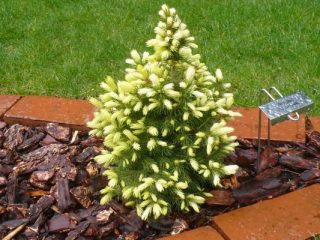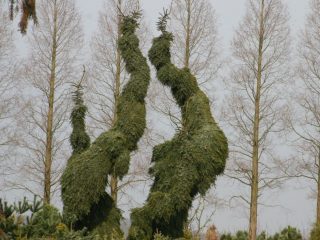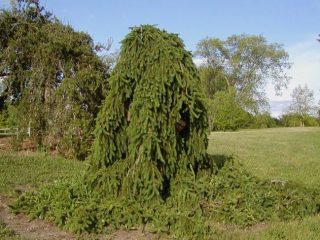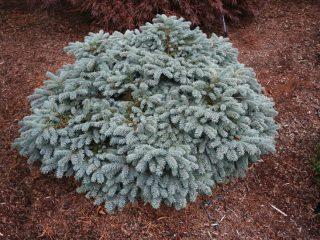Content
It is quite possible to take cuttings of blue spruce at home if you study and follow agrotechnical rules. This method is considered more effective and simpler than other methods of reproduction. The tree obtained from cuttings quickly adapts to open ground and takes root better.

Cuttings of blue spruce do not cause any particular difficulties for gardeners
Is it possible to propagate blue spruce from cuttings?
Reproduction of any coniferous plants is most often carried out in two ways. This can be done with seeds, but it is easier, according to experts, to grow blue spruce from cuttings. In addition, cuttings significantly increase the chances of growing a beautiful and healthy tree.
However, this method has its own subtleties, which it is recommended that anyone who plans to engage in crop propagation should know about.
Advantages and disadvantages of the method
Despite the fact that cutting a crop is more effective than propagating it by seeds, in addition to its advantages, this method also has its disadvantages. For those who are afraid of encountering difficulties or do not want to wait several years for the tree to grow, it is better to simply purchase a ready-made seedling in a specialized store.

At the same time, cuttings of several blue spruce branches are carried out, since the probability of each rooting is only 80%
Advantages:
- ease;
- maximum guarantee of results;
- fast rooting;
- high survival rate;
Flaws:
- low ability of cuttings to produce developed roots;
- slow tree growth even when propagated by cuttings.
When to take cuttings
Typically, propagation of blue spruce by cuttings is carried out in the spring, in the last week of April or early May, when the tree wakes up after winter. At this moment, all processes are activated, the plant is saturated with juice and nutrients. The scales covering the buds move apart, and a green cone appears on the branch.
If cuttings are performed correctly, roots will appear on the cut branch already on the 80th day, and in the sixth month the shoot will begin to grow.
Some gardeners carry out cuttings in the summer, often in the second half of July. But in this case, it should be borne in mind that the seedlings may not have time to form roots, which is why they will begin to take root only next year.
Reproduction of blue spruce by cuttings at home
Rooting blue spruce cuttings at home usually takes a couple of months or a little longer. But before planting the tree in a permanent place, it will have to be looked after for several years.If cuttings, growing and caring for seedlings were carried out in compliance with all the rules, then they will be able to take root well in a new place and form full-fledged trees in about 3-5 years.
Rules for taking cuttings
A good result can be achieved only if you carry out cuttings of blue spruce in accordance with agrotechnical rules. The first thing that is required from the gardener is to prepare the required number of cuttings, for which it is better to give preference to a Siberian spruce of a silver, blue or bluish appearance as a mother tree.
Next, to carry out cuttings, you need to find a healthy, undamaged, young spruce (up to 40 years old) and shoots that are no more than ten years old. Then on a cloudy, non-rainy day you need to do the following:
- Break off a branch from a side shoot with your hands so that it is no longer than 10 cm.
- Make sure that the bark is preserved on the shoot.
- Clear the bottom of the branch from needles.
- Treat the cut with any root former.
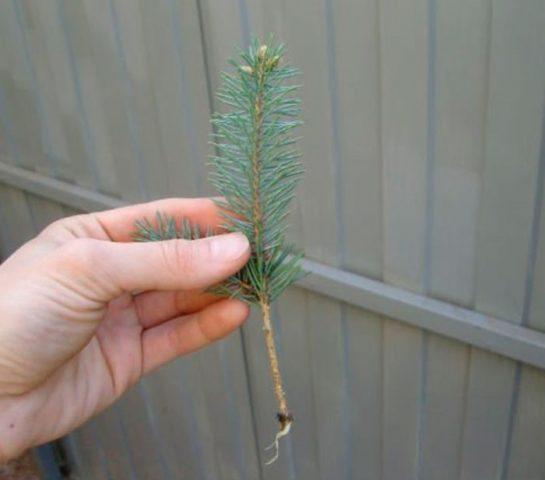
The most viable cuttings are located on the upper branches of the spruce
Germination of cuttings
After the planting material has been received from the mother tree, it becomes necessary to germinate it, but before that it is advisable to place the branches in a sugar solution for a day.
To root blue spruce cuttings, you can use the following instructions:
- Place a drainage layer of peat and dry bark at the bottom of a previously prepared container.
- Fill the box with a mixture consisting of garden soil, sand, peat and perlite.
- Moisten the resulting substrate.
- Plant the cuttings at an angle of 45 degrees in holes 3 cm deep at intervals of 30 cm.
- Compact the soil, cover the top layer with river sand and mulch.
- Water the plantings, cover with film and put in a shaded place.
Before the cuttings take root, they will need to be regularly moistened and ventilated daily. Additionally, it is recommended to spray the planting material, as well as the room itself, with water. In addition, you should loosen the soil around young seedlings quite often.
How to plant blue spruce from cuttings
A strong root system in blue spruce, for propagation of which cuttings were chosen, is formed approximately in the third year of life. Although, according to experienced gardeners, in order to get a truly strong and durable tree, you need to keep it in greenhouse conditions until it is five years old. Moreover, in the cold season this should be done in a cool place under a covering material, and in the remaining months it should be hardened in the fresh air.
Specimens are planted in open ground in autumn or spring in lighted areas with moist soil. Before the procedure, the seedlings are moistened.
Further care
After the spruce cuttings are completed, the plant needs standard care.Gardeners provide seedlings with moderate watering, mandatory loosening, and mulching of the tree trunk circle. The tree does not need fertilizer, but if desired, you can feed it lightly. Formative and sanitary pruning is also considered a mandatory procedure for caring for conifers.
Watering
Blue spruce, although considered a drought-resistant tree, still loves moisture, and it is undesirable to allow it to dry out. If the tree is young, then moisturizing should be done 1-2 times a week depending on weather conditions; an adult tree needs to be watered once every two weeks.

To wash off dust from the spruce and give the needles a rich blue color, you can spray its branches with water from a hose
Top dressing
Blue spruce grown by cuttings does not require frequent feeding. The only thing the plant may need is to add fertilizer to the soil near the trunk in the spring until shoots appear. Also, mulch in the form of compost, peat or sawdust can serve as a nutritional supplement for the plant.
Loosening and trimming
Blue spruce prefers loose soil, so it needs to be periodically fluffed around the trunk. The work should be done carefully so as not to damage the root system. Tree pruning is recommended as needed. This is usually done in spring and autumn if there are dried or damaged branches. Blue spruce also requires formative pruning to create a beautiful crown.
Transfer
Blue spruce obtained by cuttings tolerates transplantation well.Although it is advisable to immediately select a suitable place for it on the site and not worry about transferring it from one place to another. If the need to carry out this procedure nevertheless arises, the gardener will need to dig a hole in the new bed slightly larger than the root system of the tree, add a layer of drainage, soil and sand into it, and then replant it using the transshipment method.

During transplantation, blue spruce should be buried so that its root collar remains above the ground
Pest Control
Blue spruce is often attacked by harmful insects, so it is important to regularly inspect the trees to identify their presence as soon as possible. One of the most frequent guests on the plant is the spruce sawfly, which is recommended to be combated with the drug Fufanon (20 g of substance per 1 liter of water). Burnt shoots of blue spruce will indicate the presence of an insect.
Another enemy of the plant is spruce-fir hermes. Lumps of white cotton wool under the tree indicate its invasion. Spring treatment of spruce with Antio or Rogov solution (20 g of product per bucket of water) will help remove it.
Conclusion
Cuttings of blue spruce allow you to relatively quickly obtain a large number of young seedlings of the crop. This conifer is often used to decorate the landscape design of personal plots, gardens and park areas. The plant has won love due to its immunity to air pollution and good resistance to drought and cold.If cuttings and planting are done correctly, and the crop is properly cared for, a positive result will be guaranteed.
